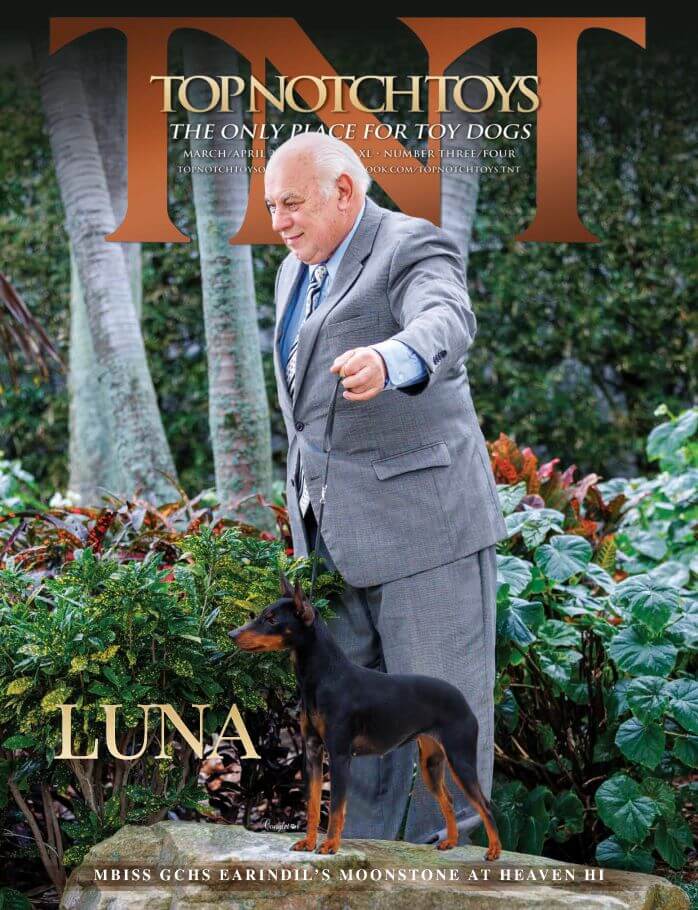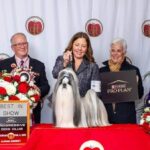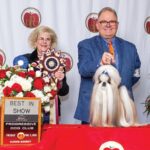My name is Sharon Masnick and I have owned a Pomeranian since I was 18. I began to be interested in the entire Toy Group when, for 17 years, I handled the advertising and editorial for Top Notch Toys.
SHARON MASNICK
 I resigned in 2011 to pursue judging. I am now happy to say that I can judge BIS, the Toy Group, Junior Showmanship, Azawakhs, Shetland Sheepdogs, and several Non-Sporting breeds.
I resigned in 2011 to pursue judging. I am now happy to say that I can judge BIS, the Toy Group, Junior Showmanship, Azawakhs, Shetland Sheepdogs, and several Non-Sporting breeds.
Recently, I read an article in the January 2021 issue of Top Notch Toys entitled, “Pomeranian Structure Equals Healthy Function.” Most of the article was educational, but one sentence just stood out to me: “It is apparent to me that we have let irresponsible judging lead to irresponsible breeding, and that judges are unaware that the decisions they make in the show ring promote the lameness problems in our breed.” I thought, “How many people agree with this statement and how many breeds do they think that about!?” So, I decided to elaborate on this sentence.
As a judge, our main consideration is the dog’s conformation or overall appearance, temperament, and structure. We, as judges, are looking for characteristics that allow the dog to perform the function for which his or her breed was bred to accomplish.
It is the responsibility of breeders to breed, train, and show sound dogs in all breeds—not just Pomeranians. All breeders should be able to screen for the difference between a show dog and a pet puppy. So, all breeders must study and know their standard and how to interpret it. Standards list dozens of required characteristics. The logic here is “pet quality” means that a dog is not a candidate for breeding or the show ring. So, limited registration can be used to prevent pet quality puppies from being bred or shown. Again, it is the responsibility of responsible breeders to focus on producing healthy, sound dogs that meet the breed standard. It is the job of breeders to select only show dogs to go into the ring to be evaluated by judges. If you realize your dog has stifle problems, an incorrect bite, is long in body, has
incorrect angulation, incorrect shoulder layback or other problems, then do not enter the dog in the show ring.
Not every dog meets the requirements to be a show dog. It is not a judges’ responsibility to breed and grade dogs to be shown to them. Breeders must step up and only allow sound dogs to be shown. If you want to breed better dogs, do not be afraid to seek help. Always strive with every litter to improve the quality. We all know there is not a perfect dog, but it is our goal to try; it takes years to establish a
breeding program.
Judges do need to be careful in their selections and, perhaps, withholding a ribbon when necessary or excuse any dog for lack of merit. Judges are on a schedule, but maybe they can ask the person to stay around for a while and perhaps a mentor could be suggested. We want to encourage people to show dogs, not discourage them from
showing dogs.
In closing, breeders, be proud of what you breed and show. It starts with you and the whelping box. Judges can only evaluate what is entered and shown to them.
I have asked several Pomeranian breeders and judges to comment on the article in hopes of improving the dogs being bred and shown. Their thoughts and ideas follow this article.
CHRIS & JOHN HEARTZ
 Breeding a better Pom is a constant struggle toward achieving a balance of type, soundness, and health. You cannot succeed at breeding one without the others. Our Breed Standard gives us a clearer picture of what a Pom should look like, the breed characteristics (type), and it also explains how they should be built to function properly (soundness). However, Breed Standards are open to interpretation and they also vary from country to country, so some characteristics will vary slightly. Breed Education is so important as it will imprint what correct breed type is to both breeders and judges alike.
Breeding a better Pom is a constant struggle toward achieving a balance of type, soundness, and health. You cannot succeed at breeding one without the others. Our Breed Standard gives us a clearer picture of what a Pom should look like, the breed characteristics (type), and it also explains how they should be built to function properly (soundness). However, Breed Standards are open to interpretation and they also vary from country to country, so some characteristics will vary slightly. Breed Education is so important as it will imprint what correct breed type is to both breeders and judges alike.
Health in our breed has come much more to the forefront in the last 10 years, and this is important as well. Poms have not been the soundest breed, and it is nice to see an increasing number of Poms being recognized for their CHIC certification in the Pom Review. So, alongside type and soundness, health issues become the third part of the breeding puzzle.
As well as understanding the breed characteristics, a breeder must also study movement to determine what a good front is, what a good rear is, and how these work together to create balance with effortless movement. It is the responsibility of breeders to learn to achieve type with soundness in their breeding program, so judges will have quality exhibits to evaluate.
No judge can be expected to be a breed expert in every breed, but they are tasked with evaluating what is before them in the ring. Those who know and, perhaps, have even bred Pomeranians will usually choose the exhibits with the most type and then place the soundest of these. However, judges not as familiar with a breed may choose the soundest of the exhibits—modified by what they perceive as correct type. This is where breed education will be able to assist. It is important to remember that any dog can be sound, but without breed type it is just a dog. Also, before criticizing a judge’s performance, remember that they must make their determination in about three minutes per exhibit. It is also important that breeders be able to honestly evaluate their own exhibit(s) against those of the other exhibitors in the ring. Then, if they place where expected, they will realize that that judge’s opinion is aligned with their own. In any case, as a breeder, you should always have a general idea of where you should place in a class and why you’ve won or lost.
It is the breeders and the breed clubs that are responsible for educating judges about the breed. It is not the judge’s job to educate the breeders as to what they should be breeding and showing. As said previously, type, soundness, and the health of our breed must begin with the breeders.
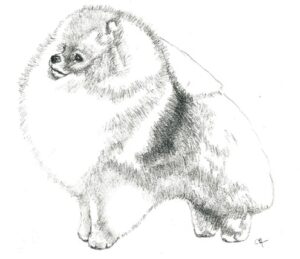
ABOUT THE AUTHORS
Christine and John Heartz, Chriscendo Pomeranians, Brookfield, Nova
Scotia, Canada.
Chris and John began their involvement in the breed in 1970 and bred their first litter of Poms in 1977. John was an All-Breed Professional Handler, retired in 2000. He brings to the table the breeding of Pembroke Welsh Corgis and the handling of breeds in all seven Groups to multiple BIS, and an excellent knowledge of structure and function. Together, they have bred, owned, and campaigned Poms that have won almost 200 BIS and Top Dogs in many countries around the world—Canada, USA, Thailand, Indonesia, Russia, Brazil, Denmark, and Australia, to name a few. Their dogs are behind many of the top dogs in the breed today. The Chriscendo dogs have also been top-producers for other breeders around the world. The Heartz’ continue to breed top-winning dogs today.
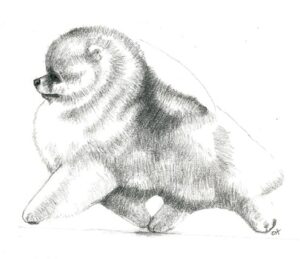
BRENDA SEGELKEN
 AKC Judge Brenda Segelken, breeder/owner-handler of Fame Pomeranians, was former Editor of the Pomeranian Review. Elected by the APC Membership, she judged the APC National in 2017. Brenda has served on the APC Board of Directors and is a Life Member of the American Pomeranian Club, Inc.
AKC Judge Brenda Segelken, breeder/owner-handler of Fame Pomeranians, was former Editor of the Pomeranian Review. Elected by the APC Membership, she judged the APC National in 2017. Brenda has served on the APC Board of Directors and is a Life Member of the American Pomeranian Club, Inc.
“It is apparent to me that we have let irresponsible judging lead to irresponsible breeding, and that judges are unaware that the decisions they make in the show ring promote the lameness problems in our breed.”—TNT,
January 2021
Response:
When I read the writer’s sentence above, the first thing that stuck out in my mind was “WE.” More specifically, “WE have let irresponsible judging…” Who is the “WE” within this sentence? Rightfully stated then, “YOU” are now taking on the responsibility of irresponsible judging and breeding. But “WHO” actually holds the ultimate responsibility of the dogs in
the ring?
Many highly respected AKC judges of the past and present have taught, “When judging, first decide which dogs in the ring are of the correct breed type. From those, then select the best structure.” Judges should not put up a pet quality Pom just because it can move correctly.
Breeders who participate in conformation competition do take part in an evaluation of breeding stock by knowledgeable judges. This selection process can assist in breeding decisions. However, it is the responsibility of the exhibitor to decide if an individual dog is worthy to represent the breed before even taking it into the ring.
Every breeder’s program must provide balance to achieve the end goal; a dog of correct breed type, healthy (structure included), and with correct breed temperament. If a breeder is over-stressing the importance of any one thing, the results (over more than one generation) could be very undesirable. Being a conscientious breeder is similar to a juggler juggling many objects.
This article in question mainly addressed luxating patellas and their relationship to the front and rear angulation. Front and rear angulation, along with their balance, will affect correct movement. However, there are a multitude of other possibilities for luxating patellas. The breeding goal of eliminating luxating patellas should be addressed by every breeder as well as by the breed club.
Many health concerns that should eliminate a dog from a breeding pool would not be visible and discernable while inside the show ring. The breeder’s final judgment of what to breed to whom should be one of serious study of the breed and of the Pomeranian standard. Judges do play an important role, but not in the whelping box. To be sure, not every show dog or champion should be bred. Ultimately, the responsibility of breeding decisions remains with the breeder.
We must have patience with judges who are learning to judge the Pom, as well as with our novice breeders and exhibitors. I applaud those who have a lifelong passion to breed and exhibit Poms as conscientiously as possible. It is a never-ending, evolving challenge to produce beautiful, healthy Pomeranians with good temperaments.
DAVID &
CARLENE GILSTRAP
We are David and Carlene Gilstrap. We’ve been breeding Pomeranians under the name of Mountain Crest for over 30 years. We pride ourselves on the structure of our dogs. In our 30-plus years of breeding, we have seen many changes in our small breed—some good and some not.
It is a well-known fact that Poms are the number one bred for luxating patellae. If you research luxating patellas, you’ll find it is usually a genetic condition. Though it can be caused from an accident, most of the time it is genetic. It is not caused by a bad front or shoulder placement. A shoulder placement may cause some stress on the rear, but it does not cause a bad rear. The front shoulder assembly and the rear assembly are two separate parts of the body.
Because the patella problems in our breed are mostly genetic in origin, it would be a breeding problem. With that said, it is up to the breeder to try and breed out the bad patella—no one else can do it. It is up to the breeder to recognize when a line has a patella problem. It is not an easy task to breed out 100 percent of the bad patellas or any other genetic disorder. We will not do it by blaming someone else or by making our breeding decisions on what goes on in the judging ring. At the end of the day, it is your dog, your breeding program!
ROXIE CAMPBELL
I have owned and loved the Pomeranian breed since I was five years old. I had polio as an infant and, growing up, I required many surgeries. My grandmother had a friend who gifted her a retired champion that was then gifted to me. This dog was my constant companion until he passed at the age of 18.
I began attending shows in the early 1970s. I had an opportunity to observe many of the great dogs of that time. I learned about structure, pedigrees, and breeding programs. Sue Goddard, Randy Frech, Nina Epps, Erika Moureau, and Darrell and Olga Baker were a few of my mentors. I bred a few litters and finished several champions under their guidance. By the mid-80s, I made the difficult decision to step away from dog shows to raise my family and start my retail business. I still, however, had my dogs and made every local show to observe and visit with my show family.
I semi-retired four years ago when I began looking for a show prospect. I was determined to find a nice black or black and tan dog for the ring. I was being very particular and, with the help of Erika Moureau and Charlotte Creed, I was introduced to Annette Rister. I purchased “Freddie” from Annette and his show career began at six months. He has been a delight to watch in the ring. He obtained his grand champion with several Group placements as well as a Best Puppy in Show, Best Bred-By in Show, and several other honors. Annette handled him for most of his show career. (Previously, I’d finished many of my own dogs, but wasn’t confident enough in myself to go back in the ring after my cancer battle six years ago.) Freddie is being bred very selectively to approved bitches and has several very promising puppies on the ground.
Good breeders who breed to our standard and breed for the betterment of our breed are to be commended. Breeders are responsible for what is being shown in the ring, not the judges. It is sad to see some of the dogs being presented in the ring today. The quality of the dogs in the ring, again, goes back to the breeders’ ability to honestly evaluate their show prospects.
CHARLOTTE CREED
Following Sharon Masnick, whom I have admired for many years, I agree totally with her.
My name is Charlotte Creed. I have been involved with Pomeranians for over 40 years and have bred multiple BIS Poms, the No. l male Pom in the nation and the No. 1 Pom bitch in the nation, and the top-producing male and female in the nation. I have been blessed with many great mentors in my lifetime in this sport. My goals were always for the betterment of
the breed.
In recent years, I have seen some trends that are concerning to me. Many Poms are being shown that are long in back, low on leg, moving with head down, and with soft coats. This is NOT correct, according to our standard—from its beginning. I firmly believe that we can, by studying our past greats, correct these trends that are detrimental to our breed. You, the breeders, are responsible for what is being shown. Learn your standard and your breed, and honestly evaluate your dogs based on the standard. Not all deserve to be in the ring. Be willing to cull wisely. If your dog looks different from what you are competing against, but is correct according to our standard, keep showing it. Good judges will eventually reward you. Don’t settle for trends. Breed according to the standard and for the betterment of the breed.
Some of you are very successful breeders of today, so always try and improve on each breeding based on the standard. For example, I saw several Poms at our National Specialty that were very, very nice and have done some very nice winning. However, if they had only had as little as 1/2 inch longer leg length they would have been great Poms. Honestly, evaluating this and breeding for that minor change would transform a very nice Pom into a Great One. Set goals to do this with each breeding. It’s all about balance!
Some of the judges have expressed concerns about open fontanels, large, round, buggy eyes, and bad mouths. This last is caused by trying to change the Pom head into a more Peke-type head. This is incorrect. Mrs. Matta of the great Matta Poms (of our great foundation Poms) discussed this problem as far back as the 1930s. When you try and change the head from what our standard says, this can happen. Incorrect eyes, incorrect pose, incorrect mouths, and open fontanels are all major defects. Breed to our standard and for the betterment of the breed.
There has been some discussion about proper layback of shoulders in our Poms of today. Many people don’t understand it. Included above is a sketch of BISA, BISS Ch. Bev Nors Toasted Fudge by Chris Heartz that I think is a good example of proper shoulder layback. (And, when the dog is moving, the head is held high, like this.)
Remember, the Pom should be short-backed with a high tail set (with a profuse tail plume), and a harsh outercoat and dense undercoat. Judges can only judge what’s in the ring. Breeders, present them with Poms that meet our standard. Don’t go for trends or fads, and I think we will see judges rewarding you for doing it right.



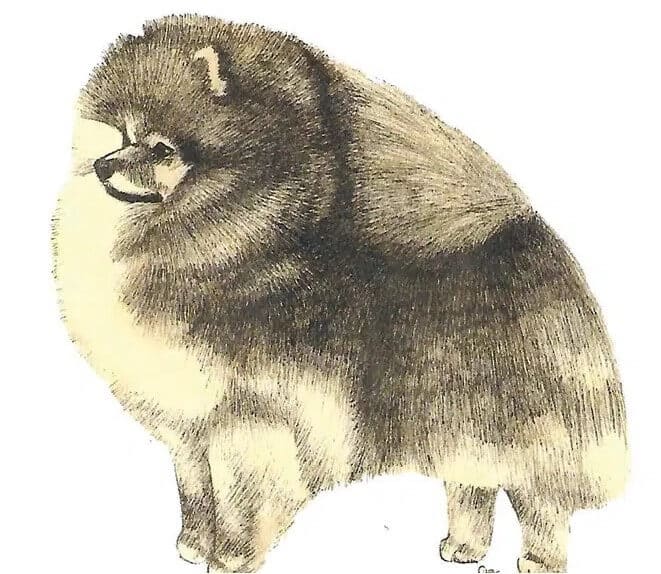
 I resigned in 2011 to pursue judging. I am now happy to say that I can judge BIS, the
I resigned in 2011 to pursue judging. I am now happy to say that I can judge BIS, the  Breeding a better Pom is a constant struggle toward achieving a balance of type, soundness, and health. You cannot succeed at breeding one without the others. Our Breed Standard gives us a clearer picture of what a Pom should look like, the breed characteristics (type), and it also explains how they should be built to function properly (soundness). However, Breed Standards are open to interpretation and they also vary from country to country, so some characteristics will vary slightly. Breed Education is so important as it will imprint what correct breed type is to both breeders and judges alike.
Breeding a better Pom is a constant struggle toward achieving a balance of type, soundness, and health. You cannot succeed at breeding one without the others. Our Breed Standard gives us a clearer picture of what a Pom should look like, the breed characteristics (type), and it also explains how they should be built to function properly (soundness). However, Breed Standards are open to interpretation and they also vary from country to country, so some characteristics will vary slightly. Breed Education is so important as it will imprint what correct breed type is to both breeders and judges alike.

 AKC Judge Brenda Segelken, breeder/owner-handler of Fame Pomeranians, was former Editor of the Pomeranian Review. Elected by the APC Membership, she judged the APC National in 2017. Brenda has served on the APC Board of Directors and is a Life Member of the American Pomeranian Club, Inc.
AKC Judge Brenda Segelken, breeder/owner-handler of Fame Pomeranians, was former Editor of the Pomeranian Review. Elected by the APC Membership, she judged the APC National in 2017. Brenda has served on the APC Board of Directors and is a Life Member of the American Pomeranian Club, Inc.